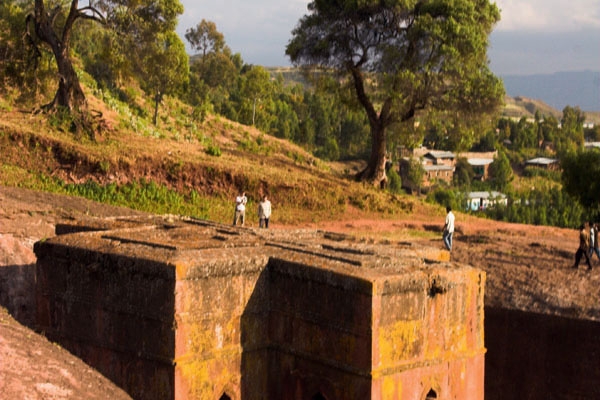By any measure the small town of Lalibela, hidden away amongst the gorges and plateaux of Ethiopia’s central highlands, is one of the most remarkable religious sites on earth. A dozen or so churches have been carved out of the rock and connected by a labyrinth of trenches, tunnels, culverts and crypts. The churches are substantial, elaborate and in their overall effect unlike anything else in the Christian world. Interiors disappear into chiselled-out arcades and apses; the light falls through intricate cruciform windows. The columns are so evenly spaced, the vaults so regular that it is easy to forget that every inch of these ‘buildings’ had to be designed and executed using negative space, a stone-carver’s technique that allows for no margin of error.
The earliest eye-witness account of Lalibela comes from the 16th century when the Portuguese traveller Francisco Alvares attempted to describe them before confessing, ‘I weary of writing more about these buildings, because it seems to me that I shall not be believed.’ Visitors from Europe and elsewhere have continued to be astonished by Lalibela, and their astonishment has been expressed in the customary fashion, through eager questions about its origins: When? How? By whom? Why? The fact that none of these questions has ever been conclusively answered only adds to Lalibela’s mystique.
Jacques Mercier and Claude Lepage bring decades of experience and expertise in Ethiopian art to decoding Lalibela. With regard to dates, they back up the
Ethiopians are a bit miffed at the assumption that their ancestors couldn’t have achieved these wonders
hagiographic version, that the churches were commissioned by King Lalibela in the late 12th and early 13th centuries. This theory stands apart from the recent work of the Cambridge-based archaeologist David Phillipson who believes that, though some of the churches may come from the time of Lalibela, the ensemble was begun earlier.
As evidence for their position, Mercier and Lepage point to the integrity of the overall design of the complex as well as to a certain consistency in the motifs and decorative detail. They also calculate that in terms of man-hours and cubic metres of extraction, the churches could have been completed in a couple of decades — a lot quicker, in fact, than building them.
One of the more contentious debates about Lalibela has been the part played — if any — by foreigners. Were Copts involved, or Arabs or Byzantines, Armenians or Indians? Or even the Knights Templar? Ethiopians have always been a little miffed at the assumption that nothing so wondrous could have been achieved by their own ancestors. Recent studies have, in the main, focused on a more indigenous provenance. The discovery of other, smaller-scale rock-hewn churches in the north of Ethiopia has helped. Mercier and Lepage back up the home-grown origins by stressing the ambition and power of King Lalibela.
Anyone visiting Lalibela is struck by the names of the sites — here is Golgotha and the Mount of Olives, Mount Sinai, the River Jordan, a mound in one of the courtyards is Mount Ararat. The inevitable interpretation is that it was all intended as a reconstruction, a kind of biblical model village. That Jerusalem had just fallen to Saladin at the time of King Lalibela — denying Ethiopians the chance of pilgrimage — appears to back this up. But Mercier and Lepage doubt that King Lalibela had really intended a replacement Jerusalem; nor do they give much credence to the suggestion that the churches represent the early Christian centre of Edessa: the site’s original name was Roha, the local name for Edessa.
The authors have each studied Lalibela — and in particular the decorative motifs, the church treasures and the iconography — in meticulous detail. The arguments they develop are broadly based and generally robust. What is given less space in their study is a sense of the fluid way that the place is perceived. Lalibela is a living pilgrimage site. Tens of thousands of Ethiopians trek there every year, as they have for centuries, bringing with them a host of expectations and narratives. Priests perform exorcisms, miracle cures take place; many pilgrims go to Lalibela simply to die.
Layer upon layer of associations have built up, clogging the aisles and the trenches with mythology. Ethiopian belief is famously ambiguous. Try to pin down what something represents and you are left with paradoxes — which makes the literal questions about Lalibela — the when, who, why — not only harder to answer but somehow less relevant.
Yet Mercier’s and Lepage’s Lalibela remains a book wholly worthy of its subject. The achievement of the churches, the complexity of their sculpted architecture, the meanings and influences of the decoration and artefacts can all be gleaned from its beautifully produced pages. If the photographs themselves lack a little of the mystery of Georg Gerster’s in Churches in Rock (1971), the probing scholarship and the sheer range of objects and surfaces studied make the impact and wonder of this book second only to heading up into the Ethiopian mountains to see the place for yourself.






Comments